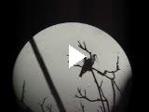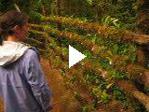Before arriving in San Jose, my father and I biked to the Monteverde cloud forest biological preserve. This preserve, at about 5,000 feet above sea level, literally sits in clouds, and is constantly blanketed by mist. We toured the forest, seeing bellbirds (see the video on the left and listen to the bird), quetzals (photo middle), monkeys, tarantulas, hummingbirds, strange insects, and much more. The forest’s thick fog provides moisture and nutrients for plants that grow on other plants, and the trees are thick with mosses and vines hanging off branches.
As with most places in the tropics, the biodiversity in Monteverde is far higher than what I am used to coming from the U.S. My hometown may have only a dozen types of trees, but here, in Monteverde, you will find hundreds of different species of trees. Likewise, there are more bird species in tiny Costa Rica than found in the entire United States.
This biodiversity, though, may be threatened, as the climate in Monteverde is already changing. As the oceans have warmed, the clouds at Monteverde are forming at higher altitudes, and the amount of mist in the forest is far less than it was in the 1970s (the photo on the left shows the clouds sitting on top of the mountain – Monteverde is behind the clouds). I talked with one researcher, Dr. Karen Masters, about what this means for the epiphytes — the plants growing on other plants, which account for half of the plant species in the forest. Her experiment (see video middle), although still underway, already shows the new conditions are poor for some species (see dead orchids on the right).
Two recent extinctions of toads in Monteverde, the golden toad and the harlequin toad, appear to be linked to abnormally warm years. A more recent paper, which looks at extinctions of toads around the world, shows that recent abnormally warm years are extremely well correlated with toad extinctions, suggesting that climate change is already playing a large role in the loss of species.
The climate is clearly changing here, and the science is backed up by common sense: if you change the climate, you will lose species that cannot adapt. There are many reasons we should preserve biodiversity, as diverse ecosystems provide better services as well as potential pharmaceutical benefits. For me, though, the strongest argument is for simple existence. Each species represents millions of years of evolution, which is completely lost every time a species goes extinct.






